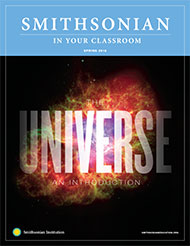|
|
 |
 |
 |
|
Getting Started |
 |
 |
 |
 |

Astronomy is a science that asks fundamental questions about the very fundament of things, the universe. How big and how far away are the planets and stars? How did they form and when? How do they move and why? Finding answers to those questions has been the highest adventure of the human mind, and yet the questions, in essence, are those of any child looking into the sky. The lessons in this issue of Smithsonian in Your Classroom address the questions, therefore, by first asking the students.
In Lesson 1, the class works together to arrange pictures from space according to the students’ best ideas of size, distance, and age. This active introduction to the cosmos can be a pre-assessment for a unit on space science. Lesson 2 is a modeling exercise in which relationships in space are brought down to a scale of two inches. Both lessons are based on educational materials created by the Smithsonian Astrophysical Observatory, in cooperation with NASA. All images needed for the lessons can be downloaded from this page.
The issue also includes a profile of Smithsonian astronomer Lisa Kaltenegger, who is in the burgeoning business of “planet hunting”—the discovery of planets outside of our solar system. The first “exoplanet” was discovered in 1995. There have been hundreds of discoveries since. The work is bringing closer to the fore a question in the back of anyone’s mind when looking at the sky: Is anyone else out there?
|
 |
 |
 |
 |

Smithsonian in Your Classroom is produced by the Smithsonian Center for Education and Museum Studies. Teachers may duplicate the materials for educational purposes.
|
 |
 |
 |
|
|
|

